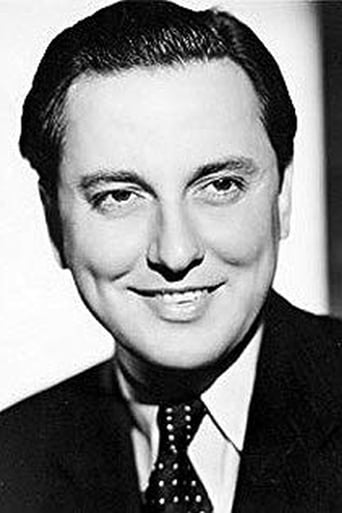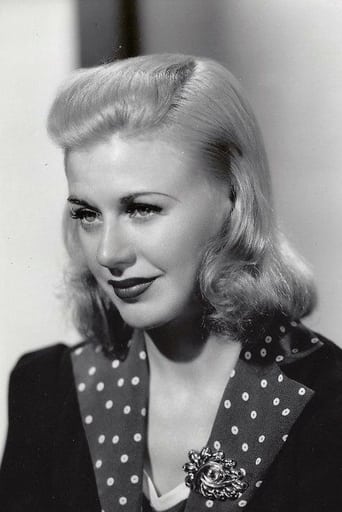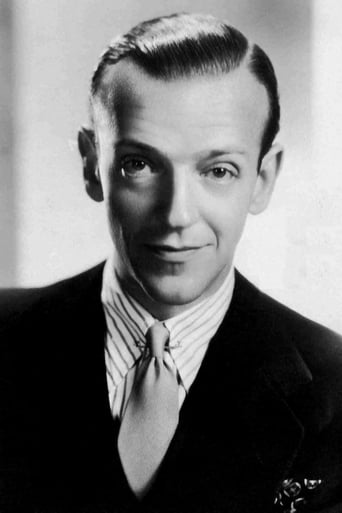JohnHowardReid
Copyright 29 December 1933 by RKO-Radio Pictures, Inc. New York opening at the Radio City Music Hall: 21 December 1933. U.K. release: 8 September 1934. 10 reels. 89 minutes.SYNOPSIS: Band leader falls for a Brazilian siren. No the bandsman is not played by Fred Astaire, nor is the vamp Ginger Rogers.NOTES: First teaming of Astaire and Rogers, albeit in supporting roles. "The Carioca" was nominated for an Academy Award for best Song, but lost out to "The Continental" from the next Astaire-Rogers movie, "The Gay Divorcée".Negative cost: $462,000. Initial domestic rentals gross: $923,000. Initial foreign rentals gross: $622,000. Net profit for the studio after deducting all expenses and overheads: $480,000. RKO's top grossing movie of 1933-34. COMMENT: A delight. The only thing I didn't like about it was that it didn't run long enough. No wonder Depression audiences were clamoring for more. Very snappy film editing. I loved all the various wipes and iris effects and the way the travelogue scenes of Rio turn into postcards and slip out of frame is as ingenious as the ghostly alter egos of Raymond and Del Rio in the beach sequence. If anything the editing is a bit too snappy during the dance sequences. The extended Carioca number is the film's highlight as is the climax with all the gorgeous girls atop the plane, but the Raymond-Del Rio flirtation is by no means dull. He is much more animated than usual and she is exquisitely costumed and photographed. Fred Astaire makes an amusing stooge and Ginger hams up the vocalizing of "Music Makes Me" delightfully. (Her part apart from dancing the Carioca with Fred and singing one song and cracking a few wisecracks is disappointingly small. She has no role to play in the story-line unlike Fred who is Raymond's buddy and stand-in). Gould tries to out-Busby Berkeley which he does in the aero number with acres of beautifully costumed dancers at his disposal so that the film often looks like Warner Bros. in its musical hey-day.In fact, this movie thoroughly deserves its cult movie reputation. Even the credits whiz by at an alarming speed. In fact the pace is so fast it's hard to believe the movie unwinds at close to 90 minutes. Full of ingenious optical effects and old-style Hollywood vigor, it all comes to a stunning climax that will entrance both vintage plane buffs and lovers of the form divine. Freeland's direction has been freely criticized of late for not doing justice to Fred Astaire's numbers by "dismembering" them with too many audience reaction shots, but frankly this habit will worry only Fred's most rabid fans. To my eyes, Freeland directs with pace and style.
jc-osms
From little acorns...Best known as the first on-screen pairing of Astaire and Rogers, I forgot that they were only playing supporting characters here, leaving me occasionally scratching my head at their extended absence from the film. Of the two, Fred gets far more screen-time. Their parts of frontline competing lovers in fact are taken by the named leads, the rather anodyne Gene Raymond and Dolores Del Rio. The other points of interest for me were the occasional camera tricks involved, for example when Raymond and Del Rio are tormented by their consciences and the off-screen depiction of the sinister gentlemen-financiers conspiring against the hotel's success, as well as the pre-Hays Code values (or lack of same) on show, quite literally on occasions, indeed our first view of Ginger sees her apparently dancing in a see-through negligee, not to mention the scantily-clad girl wing-walkers improbably assembled on the squadron of planes flown in for the big opening night.The story is typical light-comedy fluff, although I'm not sure I agreed with the conclusion which has Raymond breaking up the engagement of Del Rio and her Brazilian fiancé. The songs aren't exactly of the quality of a Kern, Gershwin or Berlin with one of them boasting, if that's the right word, the memorable phrase "wicky, wacky, wicky" to rhyme with "tricky", naturally. The humour is a bit forced at times but again there are one or two racy ribald moments which catch the ear. There's certainly a degree of ambition in some of the camera shots, particularly the extended Astaire and Rogers number "The Carioca" and the air-show at the end, obvious as the projection work is to modern eyes although some of the stunts are hilarious in their execution, notably the flying save of the girl who falls from the airborne trapeze, trust me this does happen!Otherwise the wooden doe-eyed acting of the leads and their stiff, prissy dialogue at times, plus the light-operatic musical style of some of the numbers makes the movie a little hard-going at times, but Fred and Ginger just about make it watching all the way through. I can't think when I'll ever wish to see another film starring Raymond or Del Rio but as the springboard for the greatest dance partnership in movies, I guess this feature serves its purpose.
weezeralfalfa
Now part of an inexpensive DVD set of some of the Fred Astaire & Ginger Rogers films. Although Fred was a well established musical and acting talent in theater productions, this was only his second film appearance. Earlier the same year, he had been a featured dance partner for Joan Crawford, in her semi-autobiographical film "Dancing Lady" , which included another up and coming star, Clark Gable, as the leading male dramatic star. In this film, he is again billed as a secondary character, below the much younger, but more film-experienced Ginger, and well below the top-billed romantic triangle-actors of Dolores del Rio, Gene Raymond, and Raul Roulien. Nonetheless, he is given a significant role in the screenplay, as well as several solo or partnered singing or dancing scenes. Already, he seems quite comfortable in his roles. He is loosely paired with Ginger as a dance partner and developing romantic couple, although these are not pursued as definitive. Fred and Ginger have only one dance together, and this is but one segment of the very long and varied dance fest to the catchy Latin-sounding "Carioca". Clearly, this was the take home dance song, among the few offerings composed by Vincent Youmans, Gus Kahn, and Edward Eliscu, and it was exploited for all it's potential. It was hoped that the new dance format accompanying this song, including the touching of foreheads of the couples, would catch on as a dance craze. However, this didn't happen. I thought it looked interesting. As performed by some of the more exuberant dance couples, it would have been censored late the following year, when the Hays commission standards were raised, as too erotic. Some of the dance choreography looked like it was inspired by Busby Berkeley, who was then with Warner....The second most memorable song was "Orchids in the Moonlight", sung by Raul Roulien to his sweetheart: Belinha(Delores), then danced a bit to by Fred and Delores, as a couple.The highly contrived screenplay begins with Fred, as the backup leader of a traveling band fronted by Raymond, taking over the podium when Raymond spies Dolores in the Miami audience, and goes to strike up a conversation. As a result, the band loses its contract: a repetitive occurrence, thanks to the skirt chasing of Raymond's character(Roger). Both Dolores and Raymond have reasons to next move to Rio, Brazil. Raymond secretly arranges to fly Dolores there in his small 2 person plane, initially in disguise. They have a romantic encounter during a forced landing, but Dolores says she's already engaged. Nonetheless, Raymond is hopeful he can change this situation. The band is booked to perform at a hotel owned by Dolores's father. Later, they are told they can no longer perform there, because the hotel lacks a permit for them to perform. Raymond conceives the crazy idea of having the chorus girls do movements on the wings of airplanes flying above Rio, while the band plays in a public area below. This is implied as being a big success(Should have been arrested as a very dangerous stunt, instead!). While flying one of the planes, Raul spies Dolores and Raymond kissing, through his binoculars(Ha!). Upon landing, he rushes to find Dolores, telling her she will soon be on her honeymoon. They rush in his car to the 'flying boat', near ready to take off for the US. One of the passengers is Raymond, who has finally given up trying to convince Dolores to break her engagement with Raul. Once they are in flight, Raul asks the pilot if he can perform a marriage ceremony. He agrees. I won't divulge the 'unexpected' ending to this increasingly daffy story.Dolores was at the early height of her film fame during the late silent era, when she was widely hailed as the female equivalent of Valentino. After a sputtering film career during the early talky period, she quit films for a while, to later reemerge in the 40s as a star of Mexican films, and character actress in some Hollywood films. She still had some Hollywood roles in her early 60s. I remember her presence in "Cheyenne Autumn" and "More than a Miracle", in the mid-'60s, for example. Plenty of background shots of Rio , including flying close to Sugarloaf, give the audience the feel that they are in Rio.Initially, Fred was not keen on the idea of making a series of films costarring Ginger, as he wanted to establish himself as a top solo performer. However, he eventually gave in to popular sentiments.During the portion of the Carioca extravaganza when lyrics were sung, there were supposedly 3 Brazilian women who successively supplied the solo vocals: Alice Gentle initially. Then, the clearly very young and beautiful Latino Movita Castaneda, and lastly the African American Etta Moten. Movita much later became the second Mrs. Marlon Brando, and is currently the last living member of the cast of this film, at age 98. Etta lived to 102, and became prominent in political affairs relating to African Americans, including more dignified roles in films.






